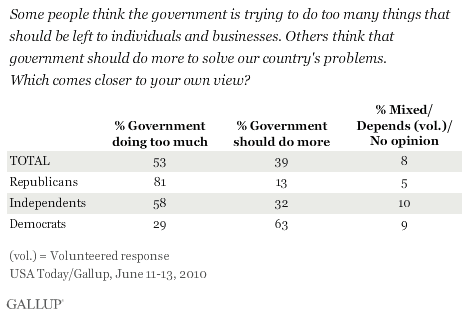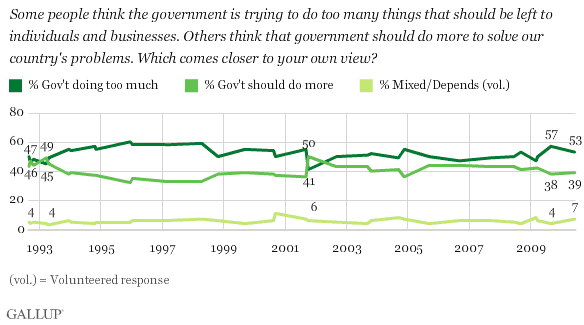PRINCETON, NJ -- A USA Today/Gallup poll finds that 81% of Republicans say the government is trying to do too much that should be left to individuals and businesses, while 63% of Democrats say government should do more to solve the country's problems -- underscoring what will certainly be one of the most contentious issues facing voters in this fall's midterm elections. Independents on average tilt in favor of saying the government is doing too much, making this also the majority view of all Americans.

The 53% of all Americans who say the government is doing too many things that should be left to others is down slightly from a survey conducted in late August/early September of last year, but is generally on par with Gallup's historical trend. In the 18-year history of this question, there have been only three points when a plurality thought the "government should do more": in 1992 and 1993, and immediately after the Sept. 11 attacks, in October 2001.

The highest percentage favoring the "government doing too much" option was 60%, recorded in December 1995.
Bottom Line
The issue of government involvement in social and economic policy will almost certainly arise at the confirmation hearings of Elena Kagan, President Obama's nominee for the Supreme Court, which began Monday. The issue will also be of major significance in this fall's midterm elections, as evidenced by the heated debate already underway on the role of the federal government in the nation's healthcare system.
Despite the fact that a majority of Americans say the government is doing too much, recent Gallup surveys show that Americans do favor legislation that would increase government stimulus spending to help create jobs, to regulate major financial institutions, and to regulate energy output from private companies in an effort to reduce global warming. These somewhat conflicting sentiments underscore the complex nature of the relationship between the average American citizen and his or her government.
Survey Methods
Results for this USA Today/Gallup poll are based on telephone interviews conducted June 11-13, 2010, with a random sample of 1,014 adults, aged 18 and older, living in the continental U.S., selected using random-digit-dial sampling.
For results based on the total sample of national adults, one can say with 95% confidence that the maximum margin of sampling error is ±4 percentage points.
Interviews are conducted with respondents on landline telephones (for respondents with a landline telephone) and cellular phones (for respondents who are cell phone-only). Each sample includes a minimum quota of 150 cell phone-only respondents and 850 landline respondents, with additional minimum quotas among landline respondents for gender within region. Landline respondents are chosen at random within each household on the basis of which member had the most recent birthday.
Samples are weighted by gender, age, race, education, region, and phone lines. Demographic weighting targets are based on the March 2009 Current Population Survey figures for the aged 18 and older non-institutionalized population living in continental U.S. telephone households. All reported margins of sampling error include the computed design effects for weighting and sample design.
In addition to sampling error, question wording and practical difficulties in conducting surveys can introduce error or bias into the findings of public opinion polls.
View methodology, full question results, and trend data.
For more details on Gallup's polling methodology, visit https://www.gallup.com/.
